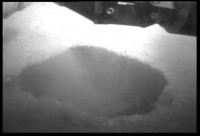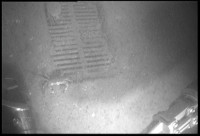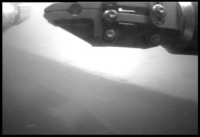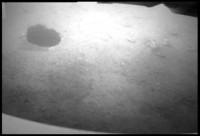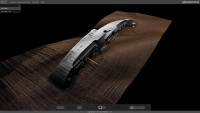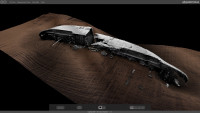Thursday, February 21 2019
SALMO operates as a specialist governmental unit that continually monitors the MoD’s inventory of around 5700 shipwrecks. Consisting of wrecks dating from the 1870s onwards, many lost during the First and Second World Wars, SALMO routinely operate not only in UK waters, but those across the world. They are responsible for overseeing all environmental and safety considerations involved in the safe treatment of harmful substances or pollutants arising from these wrecks. In coordination with the MoD, the Maritime & Coastguard Agency (MCA), the Home Office, Department of Transport and other national and international governmental organisations, SALMO represent a crucial force in maintaining the United Kingdom’s marine capacity worldwide. When SALMO’s Wreck Researcher, Matt Skelhorn, approached the Lloyd’s Register Foundation in November his enquiry concerned a seventy eight year old wreck, lying just off the coast of Great Yarmouth, the Royal Fleet Auxiliary vessel War Mehtar.
The War Mehtar was launched in October 1919 in Newcastle as a part of the Merchant Shipbuilding Advisory Committee programme, a branch set up by the government to mitigate losses to shipping during the First World War. The appointment of a Shipping Controller saw the launch of an accelerated programme of shipbuilding; all vessels built under this programme would carry the prefix ‘WAR’. Constructed by Sir W G Armstrong Whitworth & Co Ltd in their Walker-on-Tyne yard, War Mehtar measured over 400 feet in extreme length with a gross register tonnage of 5502. Her Lloyd’s Register first entry survey report notes she was built to ‘carry petroleum in bulk’, an important but dangerous function in supplying the ports and fleet of the Royal Navy. Despite this, with her launch on 9th October 1919, War Mehtar narrowly avoided service in the First World War, and remained a commercially managed Admiralty oil tanker for the duration of the interwar period.
With the outbreak of the Second World War she continued to work as an oil tanker until her convoy was targeted 15 nautical miles off Great Yarmouth. With an armed escort, the nine strong convoy FS 650, proceeded from Methil on 18th November 1941, bound for Southend. War Mehtar had been carrying fuel for the destroyer force waiting at Harwich when the convoy came under attack from the German 2nd S-Boat flotilla. These S-Boats, or E-Boats were heavily armed vessels designed to launch fast attacks close to the shore. Operating heavily in the English Channel and South North Sea, the area came to be known as ‘E-Boat Alley’ during the Second World War. Struck in the stern by a torpedo from the E-Boat S104, her cargo caught fire, forcing War Mehtar’s Captain Woodward to give orders to abandon ship. Luckily all 45 hands were rescued and safely taken back to shore. Once the attack was over, the tug Superman attempted to tow War Mehtar back to Great Yarmouth before she split in two at the bulkhead and sank at the coordinates 52.35.45 N, 02.09.30 E.
Earlier last year, recreational divers active near the wreck site reported signs of a possible oil leak to the Maritime & Coastguard Agency; who in turn alerted the MoD. At a depth of around 50 metres, just over 15 nautical miles off Great Yarmouth, SALMO report that War Mehtar was carrying roughly 7000 tons of petroleum when she sank in 1941. How much of this petroleum remains in her seven cargo holds is currently unknown, though the potential threat to the marine environment and nearby coastline has necessitated further investigation. Preliminary multi-beam sonar imaging of War Mehtar’s wreck confirms a near complete split to her hull close to her centre fore bulkhead. Despite this breach, she appears to be largely intact, though SALMO state that arrangements to survey and potentially remove the oil from the wreck are far from straightforward.
In the course of their work SALMO prioritise each individual case on a scale of 1 to 4. The most urgent cases, such as oil tankers like War Mehtar, or munitions ships, often fall into category one. Assigning a category to a particular wreck is dependent on a number of factors including, but not limited to; the potential toxicity of substances arising from a wreck or her cargo, the potential for harm to human, animal or marine life and the environment, and the proximity of a wreck to the shore. The initial work of SALMO consists of information-gathering to establish the positioning, depth and dimensions of the wreck, details of her cargo, her provenance, and the environmental conditions surrounding the site. This phase determines the severity of the case, whether it is safe and worth risking salvage, and if so will inform how any subsequent operations will be carried out. In conjunction with sonar imaging of War Mehtar, SALMO also used a Remotely Operated Underwater Vehicle (ROV) to gain footage of the wreck; however, visibility around her is poor. Speaking with Matt Skelhorn and Dr Jenny Hill from SALMO, they explained some of the particular challenges involved in War Mehtar’s case; this lack of visibility posing a significant issue. The strong currents surrounding her wreck make diving inadvisable for the time being, further compounding issues of visibility. For SALMO this has meant that sonar imaging, and information that can be gathered from historic documents and plans will be of crucial importance in the coming months.
Before approaching the Foundation’s Heritage & Education Centre, SALMO only had one profile schematic of War Mehtar in their possession. As these kinds of auxiliary vessels were not high profile, many organisations took the decision to dispose of records relating to them. During both the First and Second World Wars, Lloyd’s Register provided vital support to the British and Allied governments. Part of LR’s wartime duties involved giving priority survey to builds vital to the war effort; the Lloyd’s Register Foundation therefore holds the most complete repository of records for ships like the War Mehtar. After making contact with SALMO, we were able to locate forty documents relating to War Mehtar. These consist of midship sections, profile and deck plans, survey reports, forms, certificates, and important correspondence produced throughout her life at sea. These records contain crucial details relating to her construction, layout, maintenance, alterations, and machinery, as seen at the time of her surveys. The potential that these historic documents hold could be invaluable in research enquiries such as these. We have been informed by SALMO that these documents have already made a valuable contribution to their research; detailing the specifics of a previously unknown twelve pound gun and ammunition store on board War Mehtar.
In the coming months SALMO will continue to build up a case file on the wreck of RFA War Mehtar. The next steps will be to conduct more ROV filming, as well as a neutron backscatter test which will be able to give an indication as to how much oil, if any, is left on board the wreck. Samples of metal and seawater will also be taken for testing before a final evaluation of all the evidence; this will dictate whether it is viable, safe and ultimately necessary to undertake remediation operations. If a decision is made against removing the oil then, a range of alternative long term management measures will be considered. If, however, the decision is taken to intervene then SALMO will tender a commercial firm to remove the oil from the wreck via a process known as ‘hot tapping’. Operations such as these require a high level of technical expertise, and are both lengthy and costly. For example removing around 2000 tons of oil in 2015 from another RFA tanker, Darkdale, just off the coast of Saint Helena, cost around £9 million. In making a decision of this magnitude, the research phase of their investigation will be crucial.
As the investigation conducted by SALMO unfolds, our documents will help to give their team a greater understanding of War Mehtar, and ultimately help to inform the decision to act. The example of War Mehtar has demonstrated just how valuable our archive has the potential to be. As we digitise our archive, it remains a significant and unique resource with the power to educate and assist in the modern world in ways that we are still realising.
Exciting times lie ahead!
Access the MoD assessment of the War Mehtar wreck, including the methodology employed and further visualizations, here.






